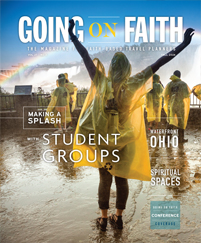The contours of the South have been shaped by its inhabitants’ faith.
Religious heritage runs through the region’s history like thread through tapestry. Travelers can learn about the influence of faith in the area by visiting some of the South’s most storied churches. Some were founded before the United States was born, and others have deep ties to Civil War figures, U.S. presidents and the Civil Rights Movement.
Cathedral Basilica of St. Louis
New Orleans
St. Louis Cathedral is one of the most recognized buildings in New Orleans’ French Quarter. The current church was constructed in the 1850s, but the first church in this location was built in 1727 and dedicated to King Louis IX of France. The Great New Orleans Fire in 1794 destroyed the church, and it wasn’t until the 1800s that a new church was completed.
Andrew Jackson visited the cathedral in 1840 when an oration was given in his honor. He had triumphed over the British 25 years earlier, and a monument to him was built in the square. In 1847, Zachary Taylor, a hero of the Mexican War, attended a service at the church. After the service, he rode his battle horse through the streets of the city to the St. Charles Hotel.
The most important visitor to the cathedral was Pope John Paul II, who came in 1987. Shortly after his visit, the cathedral was upgraded to a basilica.
The basilica features a towering center spire and two smaller spires. A statue of Jesus dominates the St. Anthony Garden at the rear of the church. At night, lights project the statue’s shadow onto the cathedral. The interior is open for self-guided tours when not in use for mass and other religious functions. The stained-glass windows and paintings in the church are well worth a visit, as is the Rococo-style gilded altar.
The Cathedral of All Souls
Asheville, North Carolina
Consecrated in 1896, the Cathedral of All Souls was built at the request of railroad tycoon George Vanderbilt, who had decided to make the mountains of North Carolina his permanent home. His first order of business was to build an Episcopal church as the focal point of Biltmore Village, the community associated with his elaborate Biltmore estate.
The church was designed by architect Richard Morris Hunt, who is known as the dean of American architecture. He designed the 1902 entrance façade and Great Hall of the Metropolitan Museum of Art; many Fifth Avenue mansions; and the pedestal of the Statue of Liberty. He also designed Vanderbilt’s Biltmore Estate near Asheville and his summer cottages in Newport, Rhode Island.
The cathedral’s pulpit, lectern, high altar, bishop’s chair, chancel furniture, pews and kneeling cushions are all original. The octagonal building behind the chancel apse and ambulatory holds robing rooms for the choir. It was not part of the church’s original design but was added shortly after the building was consecrated.
Out of the six churches Hunt designed, only the Cathedral of All Souls remains. Groups can schedule docent-led tours that highlight the architecture, original furnishings, and beautiful opalescent art glass and clear mouth-blown leaded glass windows, or take a history-focused tour to learn more about the church’s beginnings.
Christ Church Alexandria
Alexandria, Virginia
Christ Church was designed by Colonel James Wren, a descendant of Sir Christopher Wren, the architect behind London’s St. Paul’s Cathedral, in the Georgian style. The historical Episcopal church, which was completed in 1773, counted George Washington and Robert E. Lee among its noteworthy parishioners. Washington was one of the first to purchase a box pew at the church when they were sold to the highest bidders. He purchased his box pew for £36.10, or $6,700 in 2023 dollars, to help pay for the last stage of the church’s construction.
Washington worshipped there until he received his commission as commander-in-chief of the Continental Army in 1775. After the Revolutionary War and after his presidency, he attended services at the church anytime he was in Alexandria. President Franklin D. Roosevelt, first lady Eleanor Roosevelt and British Prime Minister Winston Churchill worshipped at Christ Church on New Year’s Day 1942 as part of a National Day of Prayer after the Japanese attacked Pearl Harbor.
Groups can take a tour of the church to see George Washington’s pew as well as markers attached to it commemorating the historic 1942 visit. Robert E. Lee’s pew is also marked with a brass plate.
The church features a pulpit shaped like a top-heavy wine glass, which was installed during an 1890s restoration of the church. Ten Commandments tablets are displayed to the right of the pulpit, and the Lord’s Prayer, the Apostle’s Creed and the Golden Rule are displayed to the left.
First Missionary Baptist Church
Little Rock, Arkansas
First Missionary Baptist Church was founded in 1845 and is one of the oldest Black congregations in Arkansas. It was founded by Reverend Wilson Brown, a slave who had attended the community’s Missionary Baptist Church in Little Rock. He was able to start his own congregation with help from white members of that church. The current Gothic Revival church was built in 1882 and has been at the center of the Civil Rights Movement since the 1890s.
In 1891, more than 600 African Americans gathered at the church to protest the state’s Separate Coach Law, which required racial separation in passenger cars and train station waiting rooms. They marched from the church to the Old State House to fight against laws that denied Black people their constitutional rights. In May 1958, Martin Luther King Jr. came to Little Rock to attend Ernest Green’s graduation ceremony from Central High School. Green was the first African American to graduate from the school. King came back to Little Rock in 1963 to give First Missionary Baptist Church’s 118th anniversary sermon. That was four months before he gave his famous “I Have a Dream” speech.
The church was added to the National Register of Historic Places in 1983. Travelers can visit the church as part of the Little Rock Historic Church Tour, developed by the Little Rock Convention and Visitors Bureau, to highlight 20 of the city’s oldest churches from many denominations.
Cathedral Basilica of St. Augustine
St. Augustine, Florida
The Cathedral Basilica of St. Augustine is America’s oldest Catholic parish, dating back to the founding of St. Augustine by the Spanish in 1565. The Spanish landed at the site on the feast day of Saint Augustine of Hippo, so the new settlement was named San Agustin. They held a mass there and quickly built a church.
During a war between the Spanish and English in 1585, the city of St. Augustine was captured by Sir Francis Drake and burned to the ground, including the church. It was quickly rebuilt, but several incarnations of the church were destroyed over the years. After the English gave Florida back to Spain in 1784, Spanish royalty requested that a new church be built. It was completed in 1797 in the Spanish Mission style.
The cathedral features bell gables, wooden beams and clay roof tiles. It got a much-needed facelift in 1966, and, in 1976, Pope Paul VI raised the cathedral to minor basilica status.
Groups interested in learning more about the church and its history can take a self-guided tour or a behind-the-scenes tour that brings visitors into areas of the building that are not traditionally open to the public. Tour stops include the choir loft, sacristy, confessional, baptistery and chapel. Visitors can learn about the church’s 400-year history and the paintings and stained-glass windows in the chapel or take a peek at the cathedral’s very own relic, a bone fragment of St. Augustine encased in a golden bust of the saint.









